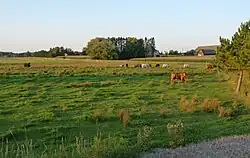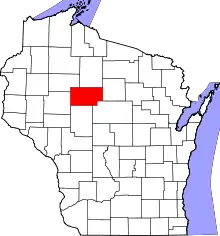Molitor, Wisconsin
Molitor is a town in Taylor County, Wisconsin, United States. The population was 324 at the 2010 census.
Molitor, Wisconsin | |
|---|---|
 This farm sits in the plain left by an ice-walled lake at the junction of M and E. | |
 Location of Molitor, Wisconsin | |
| Coordinates: 45°15′15″N 90°29′0″W | |
| Country | |
| State | |
| County | Taylor |
| Area | |
| • Total | 36.0 sq mi (93.1 km2) |
| • Land | 35.3 sq mi (91.4 km2) |
| • Water | 0.7 sq mi (1.7 km2) |
| Elevation | 1,427 ft (435 m) |
| Population (2010) | |
| • Total | 324 |
| • Density | 7.5/sq mi (2.9/km2) |
| Time zone | UTC-6 (Central (CST)) |
| • Summer (DST) | UTC-5 (CDT) |
| Area code(s) | 715 & 534 |
| FIPS code | 55-53550[2] |
| GNIS feature ID | 1583734[1] |
| PLSS township | T32N R1W |
Geography
According to the United States Census Bureau, the town has a total area of 36.0 square miles (93.1 km2), of which, 35.3 square miles (91.4 km2) of it is land and 0.7 square miles (1.7 km2) of it (1.86%) is water.
Most of Molitor is hilly, with small glacial lakes. It lies within the Perkinstown terminal moraine, which is described under Taylor County. Among the hills are some flat areas with rims which were the bottoms of ice-walled lakes after the last glacier receded.[3]
Three of Taylor County's twelve state natural areas lie in this town: Lost Lake Esker SNA,[4] Twin Lakes Bog SNA,[5] and Mondeaux Hardwoods SNA.[6]
History
The east side of the six mile (10 km) square that would become Molitor, which lies on the Fourth Principal Meridian, was first surveyed in May 1847 by a crew working for the U.S. government. Then in the winter of 1857 and 1858 another crew marked all the section corners in the township, walking through the woods and over frozen swamps, measuring with chain and compass.[7][8] When done, the deputy surveyor filed this general description:
This Township contains numerous Tamarac and Cedar swamps but very few of much extent and Generally unfit for cultivation. The Surface is Broken and mostly 2nd rate soil and not very good for cultivation. Timber is very heavy all over the Township. Chiefly Hemlock Birch Pine and Tamarac. Tamarac and Spruce Trees principally line the Streams. There are several lake in this Township but not of much extent. There are numerous small streams running in a Northerly(?) direction (?) of which are generally Swampy among those are the East Branch of Yellow River raises in the South Easter portion of the Township and runs in a Northwesterly direction through the Township it flows(?) in a gentle current Deep and narrow not well adapted for good motive power or mills.[9]
In 1933 much of Molitor was designated part of the Chequamegon National Forest.[10]
Demographics
As of the census[2] of 2000, there were 263 people, 100 households, and 80 families residing in the town. The population density was 7.5 people per square mile (2.9/km2). There were 142 housing units at an average density of 4.0 per square mile (1.6/km2). The racial makeup of the town was 98.48% White, 0.38% Native American, 0.76% from other races, and 0.38% from two or more races. Hispanic or Latino of any race were 0.76% of the population.
There were 100 households, out of which 31.0% had children under the age of 18 living with them, 72.0% were married couples living together, 5.0% had a female householder with no husband present, and 20.0% were non-families. 17.0% of all households were made up of individuals, and 5.0% had someone living alone who was 65 years of age or older. The average household size was 2.63 and the average family size was 2.96.
In the town, the population was spread out, with 25.1% under the age of 18, 7.2% from 18 to 24, 27.8% from 25 to 44, 28.5% from 45 to 64, and 11.4% who were 65 years of age or older. The median age was 40 years. For every 100 females, there were 113.8 males. For every 100 females age 18 and over, there were 101.0 males.
The median income for a household in the town was $37,500, and the median income for a family was $43,750. Males had a median income of $28,750 versus $20,568 for females. The per capita income for the town was $18,804. About 13.1% of families and 13.4% of the population were below the poverty line, including 31.7% of those under the age of eighteen and none of those 65 or over.
References
- "US Board on Geographic Names". United States Geological Survey. October 25, 2007. Retrieved January 31, 2008.
- "U.S. Census website". United States Census Bureau. Retrieved January 31, 2008.
- Attig, John W. (1993). "Pleistocene Geology of Taylor County, Wisconsin - Plate 1" (PDF). Wisconsin Geological and Natural History Survey. Retrieved September 5, 2023.
- "Lost Lake Esker (No. 462)". State Natural Areas Program. Wisconsin Department of Natural Resources. Retrieved May 23, 2020.
- "Twin Lakes Bog (No. 297)". State Natural Areas Program. Wisconsin Department of Natural Resources. Retrieved May 23, 2020.
- "Mondeaux Hardwoods (No. 461)". State Natural Areas Program. Wisconsin Department of Natural Resources. Retrieved May 23, 2020.
- "Land Survey Information". Board of Commissioners of Public Lands. Retrieved May 31, 2011.
- "Field Notes for T32N R1W". Original Field Notes and Plat Maps, 1833-1866. Board of Commissioners of Public Lands. Retrieved May 31, 2011.
- Martin, Alex S. "Interior Field Notes (Dec. 1857-Mar. 1858)". Board of Commissioners of Public Lands. Retrieved June 3, 2011.
- "Nicolet National Forest"
